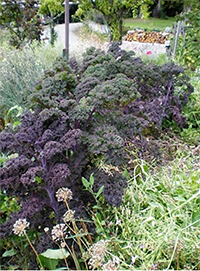Kale is not just really GOOD for you but is also one of the easiest and longest
lasting garden vegetables to grow. It has the highest levels of beta-carotene of all
the brassicas. It contains 10 times the Vitamin A of lettuce and 3 times the Vitamin
C of oranges. It also has more B vitamins than whole wheat bread, and more
calcium than milk! It is so versatile in the kitchen that Sharon Hanna describes 80
+ delicious recipes in her Book of Kale, The Easy-to-Grow Superfood, everything
from kale chips to smoothies and kale shepherd’s pie with lentils.
 Check out a 2021 seed catalogue to discover the many types of kale you can choose from, whose frilly leaves in many shades of colour will add foliage interest to your garden. Kale cultivars Bras s i c a oleracea fall into different varieties and
Check out a 2021 seed catalogue to discover the many types of kale you can choose from, whose frilly leaves in many shades of colour will add foliage interest to your garden. Kale cultivars Bras s i c a oleracea fall into different varieties and
sub species, including Curled Scotch, Tall Cur led, Drumhead, Russian, Tuscan Blue,
Labrador and Asparagus kale. Kale leaves range from slightly wavy to tightly frilled, and they ome in a range of hues – dark-green (‘Vates’), blue-green (‘Lacinato’), purple (‘Red Russian’), white (‘White Russian’) magenta (‘Redbor’).
In spring the tender shoots of flower heads can be eaten raw with dips, lightly
steamed or in stir-fries. The shoots are the most tender while the flowers are still in
bud, before they open.
!
Add dolomite lime to the garden prior to planting; kales prefer a pH that’s more
alkali than acidic. Lime also helps to keep club root at bay, a fungal disease brassicas are prone to. Sow in spring for summer and fall harvests. Direct seed ¾” deep in drills. Kale should be grown in firm ground, because its thick sturdy stalks can reach four feet tall, and they can keel over in windy conditions. The seeds are fast to germinate, taking from 7 to 10 days. Thin the seedlings to 12 inches apart in the row.
For a harvest through winter, kale is best direct sown in June/July or seeded in cell trays for transplanting by August, no later than mid-September. Kale is relatively unbothered by insects, and it does not get club root like other brassicas. Flea beetles eat small round holes in the leaves. If you have this problem, you can prevent it by using floating row covers. Cabbage white butterflies may also lay eggs that develop into cabbage worms, which eat large raggedy holes in the leaves. This problem can be kept under control by removing older kale leaves where masses of grey eggs have been deposited. Prevent disease by harvesting the larger lower leaves first, and removing any yellowed leaves.!
Winter vegetables survive freezing temperatures by pumping sugars into their cells,
which acts as an antifreeze. After hard frosts kale tastes sweeter. Once harvested
sugars quickly convert back to starch, which is why store-bought can never match
the flavour of fresh-picked kale.
!
Kale grows well in containers. So why pay $5 a bunch at the supermarket, when
fresh kale is freely available from your garden throughout the year?
!!!!!!!
TIPS FOR SEEDING SUCCESS
*Use fresh viable seeds. Do not overcrowd. Use cell trays to seed into so that
seedlings have space to develop.
*Choose sterilized, lightweight seeding mix that provides a moisture-retentive,
disease-free, well-drained medium best suited to delicate seedlings.
*Make sure you have adequate levels of three critical factors to ensure seedlings
thrive once they have germinated: moisture, light and temperature. It’s important to have consistent moisture, underwatering or overwatering causes stress. Yellow or spindly seedlings are often the result of too little light. Too much warmth together with too much moisture leads to a fungal problem called damping off.
*Seeds germinate when conditions are conducive to survival. They germinate best
when close to their optimum temperature range, which for most vegetables is
around 65-80°F (18-27°C). Peas, favas, lettuce and spinach will germinate at
cooler temperatures around 40°F (5°C), while tomatoes, snap beans, corn, melons
and peppers refuse to germinate at temperatures much outside their optimum range of 75-80°F (24-27°C).
*Food stored in the seed’s endosperm is sufficient to nourish the plant through its
period of germination into its initial period of growth. Beyond this, nutrients
must be provided by applying a weekly feed of organic liquid fish fertilizer and
liquid seaweed.
*Once they have developed their second set of true leaves the roots of seedlings
are established enough to be transplanted into their own pots or into the garden.
*Gradually harden off young plants by putting them out in the day and bringing
them in at night for at least a week. This way they adjust to cooler temperatures
more gradually. !!!!
 Carolyn Herriot is author of The Zero Mile Diet and The Zero Mile Diet Cookbook Available at your local bookstore.
Carolyn Herriot is author of The Zero Mile Diet and The Zero Mile Diet Cookbook Available at your local bookstore.
She grows IncrEdibles! in Yellow Point.
www.harbourpublishing.com/title/ZeroMileDiet
See all articles by Carolyn Herriot



